
Overview
- Fears around the US banking sector have eased since
mid-May, with central banks’ focus returning to
inflation (around 6.3% yoy in April) that remains well
above target ranges. The ECB hiked in June, and while
the US Fed paused, both banks are likely to increase
rates in July. - While market expectations suggest both central banks
are near the peak (fully pricing in one additional
increase for both), persistent inflation could drive
policy rates higher, adding downside risk to our
forecasts. - Economic growth across the major advanced
economies has been mixed, highlighted by the
contraction in the Euro-zone over Q4 2022 and Q1
2023, while Japan saw growth recover over this
period. While the fall in energy prices will help some
economies (notably in Europe and Japan) the
tightening in monetary policy is likely to keep growth
generally subdued. - Stronger readings for emerging market surveys in May
were largely driven by China. The strength of China’s
services PMI is somewhat at odds with ongoing signs
of weakness in the country’s domestic demand. Softer
goods demand in advanced economies will impact
trade activity going forward – hitting EM growth. - Overall, our forecast for global economic growth in
2023 is slightly higher this month – reflecting the
impact of stronger than anticipated activity in India, a
pushing back of the expected slowdown in US growth
to H2 2023 (which negatively impacts the global
outlook in 2024) and a pickup in Latin America. We
expect the global economy to expand by 2.8% in 2023
(from 2.7% previously), before slowing to 2.6% in 2024
(2.7% previously). Excluding the outliers of the Global
Financial Crisis and initial wave of COVID-19, this
would be the slowest rate of growth since 2001. We
expect a modest upturn in 2025 (to 3.1%).
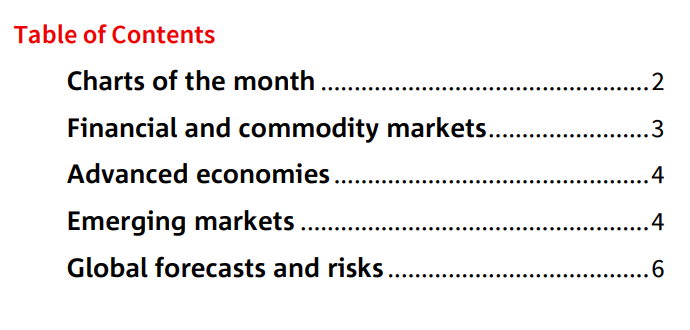
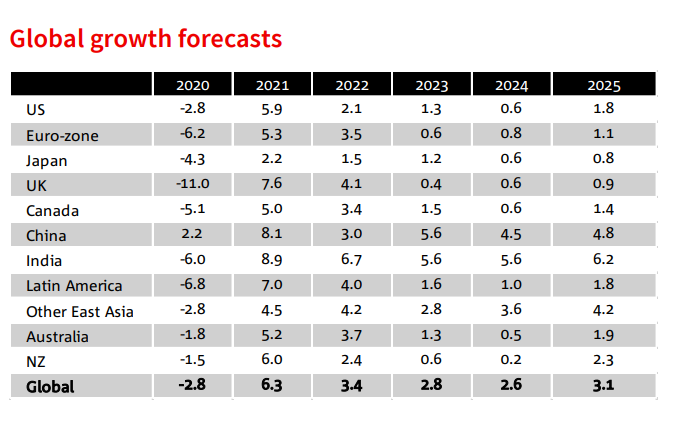
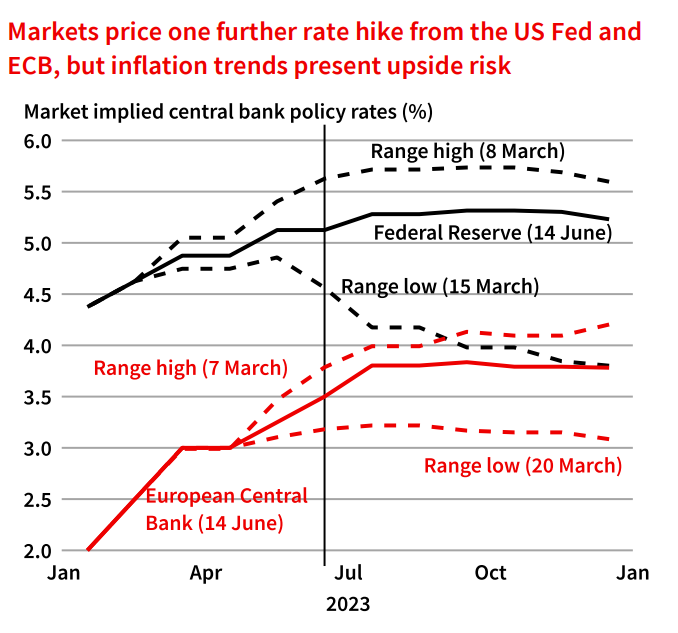
Charts of the month: Taiwan’s economy – which performed strongly in the aftermath of the pandemic – has contracted over the last year as global demand for high tech exports such as semi-conductors has fallen. This has also been a drag for Japan and South Korea, but they are less exposed to the tech cycle and the ongoing recovery in auto production has partially offset the
broader manufacturing downturn
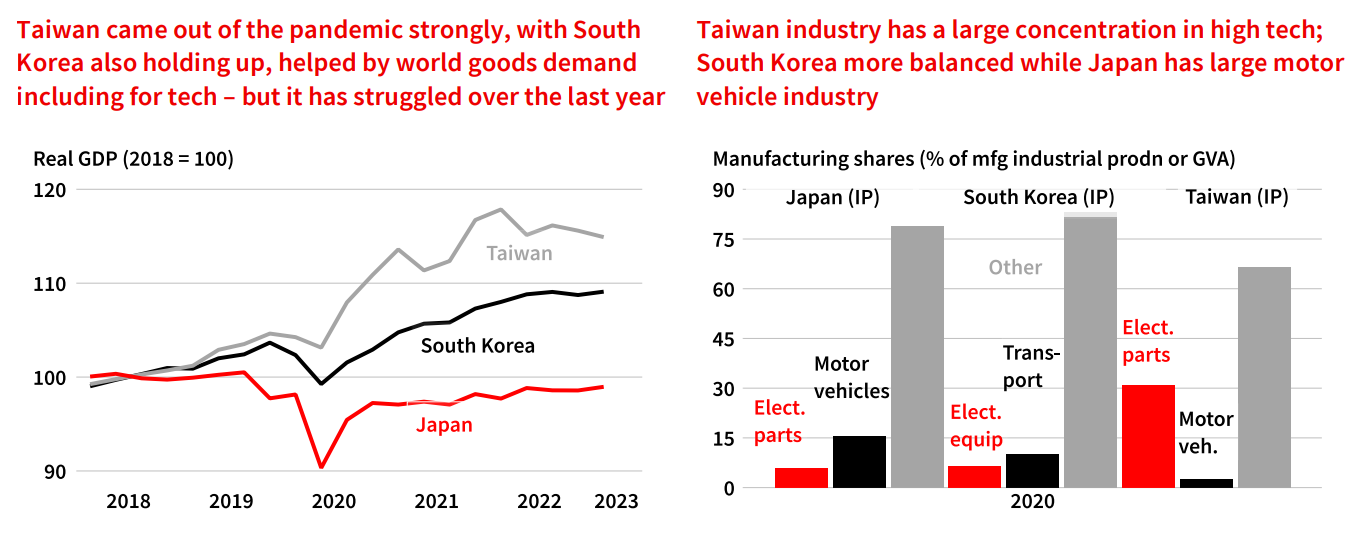
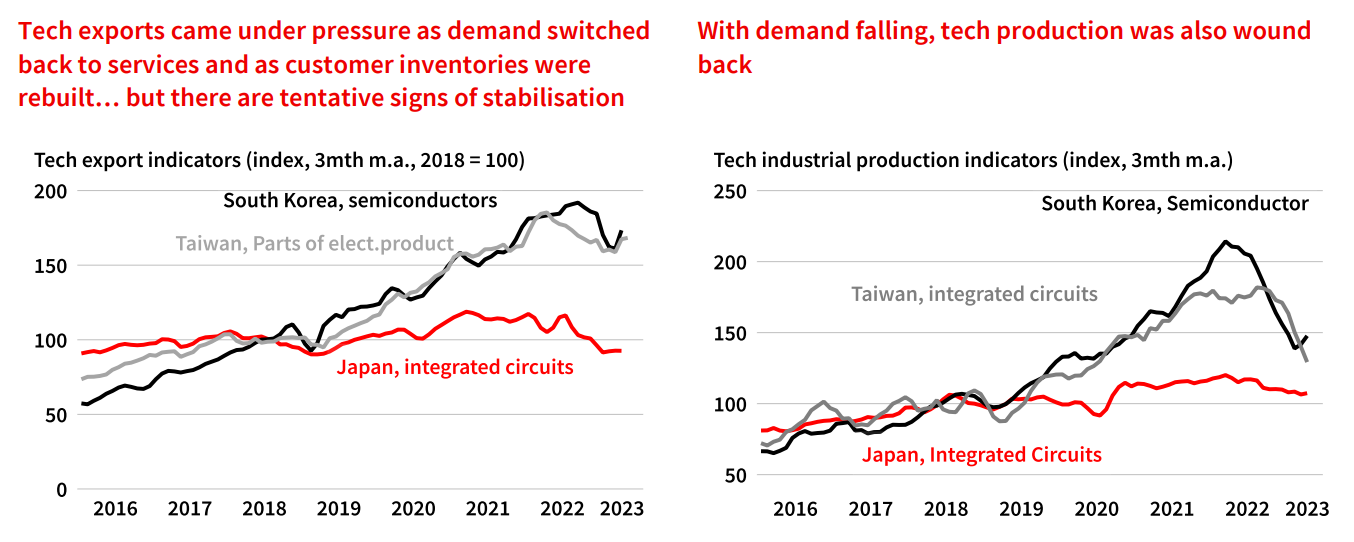
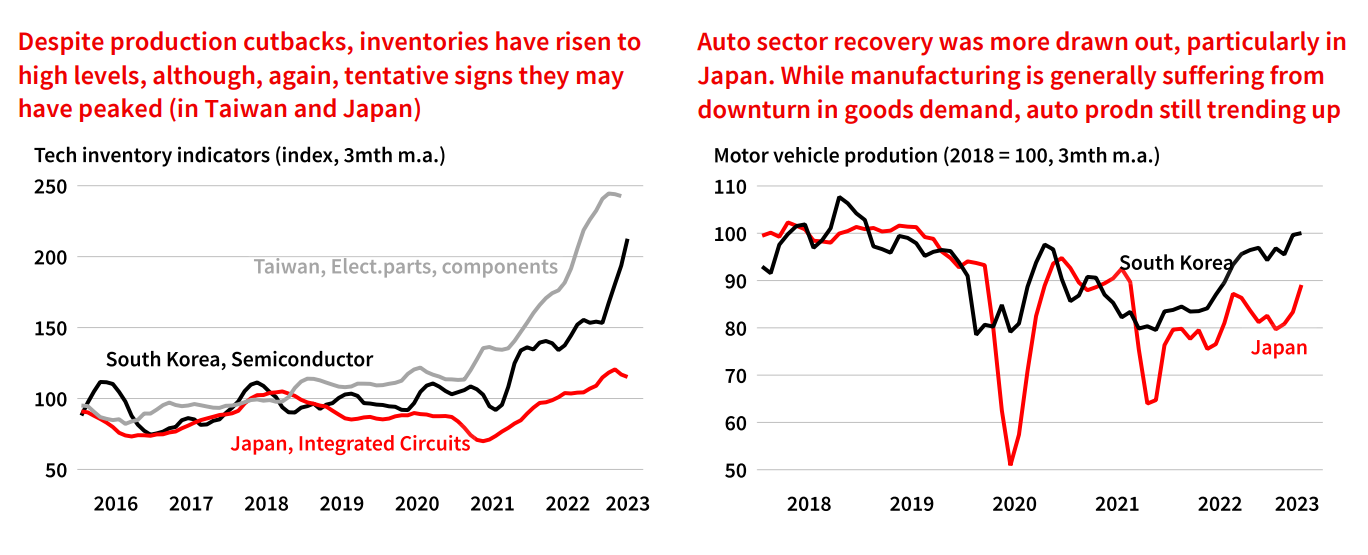
Financial and commodity markets: banking fears subside, central banks still targeting inflation
Fears around the US banking sector appear to have eased
once again – following the failure of First Republic Bank in
early May. Excluding the COVID-19 related plunge in early
2020, the US banking equities index fell in early May to its
lowest levels since August 2016, before subsequently
recovering to mid-March levels (post the initial fears).
More generally, US equity markets (as measured by the
MSCI index) have trended higher since late May (up to their
highest levels since August 2022, but still well below their
peaks of early 2022). It is worth noting that these gains
were concentrated among the eight largest tech firms
(with the rest of the S&P 500 trending lower since late
May). In contrast to the stronger trend in the US, other
advanced economies and emerging markets have
essentially tracked sideways since the start of the year.
Despite the fears around stability in the banking sector,
volatility in equity markets (as measured by the VIX index)
has generally eased in recent months – trending down
from a recent cycle peak in October 2022 (despite a
modest upturn in early March). In contrast, volatility in
bond markets has been remained relatively high – the
MOVE index is above trends observed post the Global
Financial Crisis until 2022.
Government bond yields for most major advanced
economies remain below their early March peaks – in part
reflecting a downward shift in market expectations around
central bank policy rates (with stricter lending standards
among financial institutions following the bank fears seen
as effectively providing additional monetary tightening).
The key exception is the UK, where the 10-year bond yield
rose rapidly above 4% following a higher-than-anticipated
inflation print (particularly an uptick in core inflation).
Overall, global inflation has continued to trend lower –
down to around 6.3% yoy in April 2023. While this has
slowed from a peak of around 9.6% yoy in September
2022, inflation has proved to be sticky – persisting at high
rates for longer than major central banks had anticipated.
Among the advanced economies, the US is leading the
way lower, with the CPI up 4.1% in May (despite core
inflation remaining relatively strong).
With inflation still above target in most economies, major
central banks remain on a tightening bias. The European
Central Bank (ECB) raised rates by 25 basis points in June,
while the US Federal Reserve (Fed) paused, albeit noting
that a hike in July remains in play. Market expectations
continue to suggest that both the Fed and ECB are near
the peak of the current hiking cycle (with one further hike
priced in for both institutions).
Commodity prices – as measured by the S&P GSCI – have
largely tracked sideways since early May, with lower
energy prices offset by an upturn in non-energy
commodities (on speculation of Chinese stimulus).
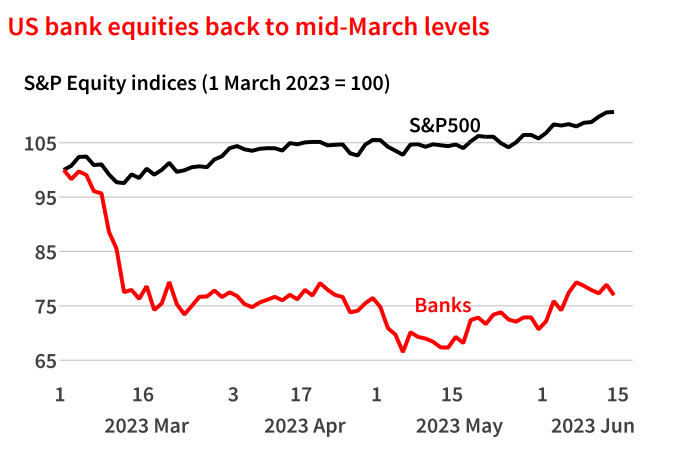
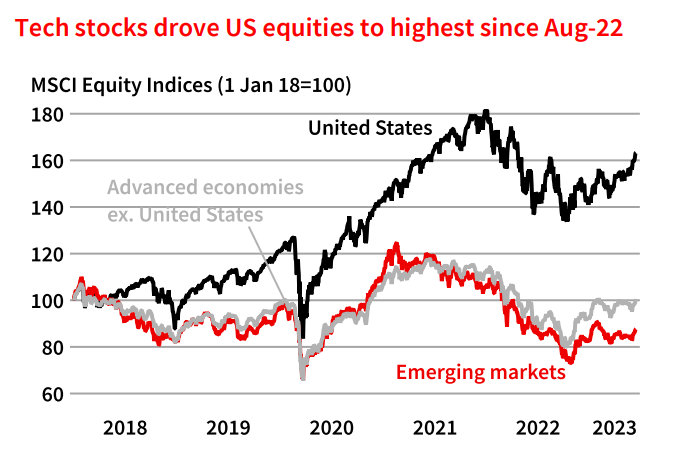
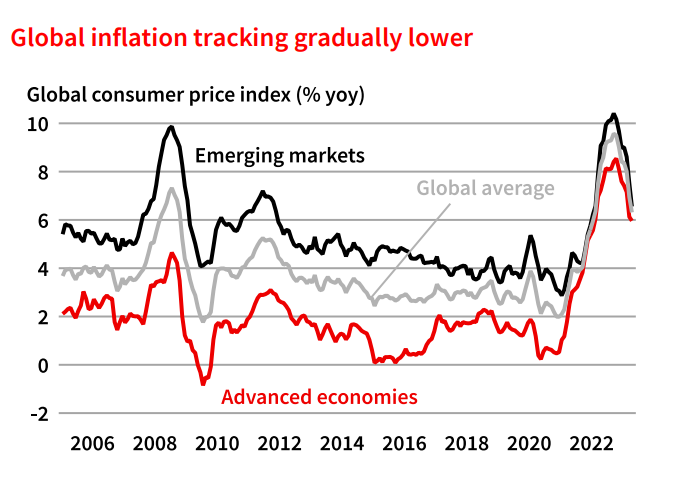
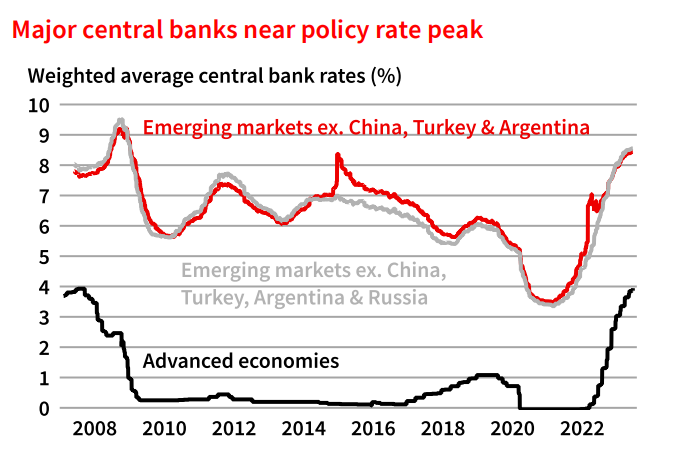
Advanced economies: As policy continues to tighten, the growth outlook remains weak
Euro-zone GDP growth in Q1 was revised down from +0.1%
to -0.1% q/q. With GDP also having fallen in Q4 2022
(also -0.1%), the ‘technical recession’ marker of two
consecutive quarterly declines has been met. These data
are still subject to revision, so conceivably it could move
out of recession again. Regardless, it is clear that the Eurozone economy came to a standstill at end 2022/early 2023
principally due to the impact of last year’s energy price
shock. This shock also weighed on the UK economy which
only grew by 0.2% over the year to Q1 2023.
In contrast, Q1 GDP growth in Japan was revised up to
0.7% q/q from 0.4%. Japan struggled in H2 2022, but is
now enjoying a bounce in growth, helped along by the
removal of remaining COVID restrictions (including on
overseas tourists this quarter). Japan’s auto sector has
also continued its drawn out recovery (see p2) and, while
weak global growth may constrain exports, the continued
rise in the PMIs suggests momentum remains positive.
We expect the Euro-zone economy will grow in Q2, helped
by the fall in energy prices. However, the continued
tightening of monetary policy is a growing headwind. The
ECB raised rates again this month and signalled another
hike in July. The net result will likely be subdued growth.
The Euro-zone PMIs are consistent with moderate growth
in Q2, even with the manufacturing sector PMI continuing
to slide. However, while still solid, the services PMI in the
Euro-zone recorded its first fall since late 2022, and the UK
services indicator fell (but both are still at a solid level).
The average of the US S&P Global and ISM services PMIs
also inched down but the two indicators moved in
opposite direction, making interpretation difficult. The
ISM measure is now at levels seen during recessions (or
their aftermath) but the S&P Global measure has been
recovering. Partial data early in the quarter point to
continued growth and so we recently moved out our
expectation of when the US economy might contract to H2
2023. We also now expect that the Fed will raise rates
again in July and pushed out the date at which we expect
the Fed to start cutting rates (to Q1 2024). This means
interest rates will be higher over the forecast horizon,
leading us to shave our 2024/25 forecasts.
While growth may have generally slowed, labour markets
remain tight, maintaining pressure on wages. Similarly,
while headline inflation is coming down, core measures
remain elevated (although there are some positive signs in
recent US and Euro-zone data). Because of this, there
continues to be upwards pressure on major central bank
policy rates. A clear, sustained shift down in inflation will
be needed to break this cycle. Accordingly, the main risk
to the outlook remains that persistent high inflation forces
central banks to raise rates to the point that there are
significant corrections in advanced economies.
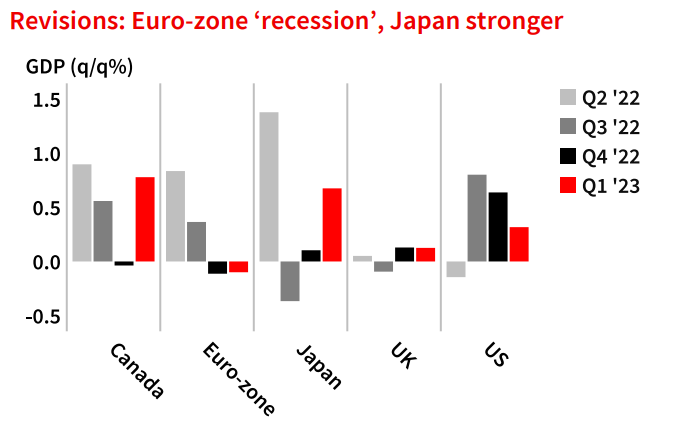
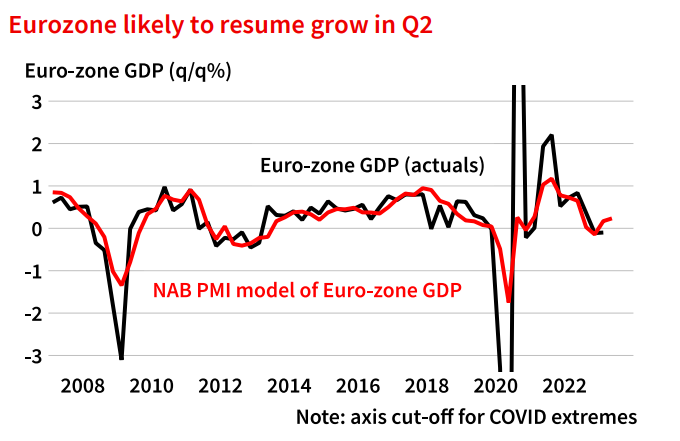
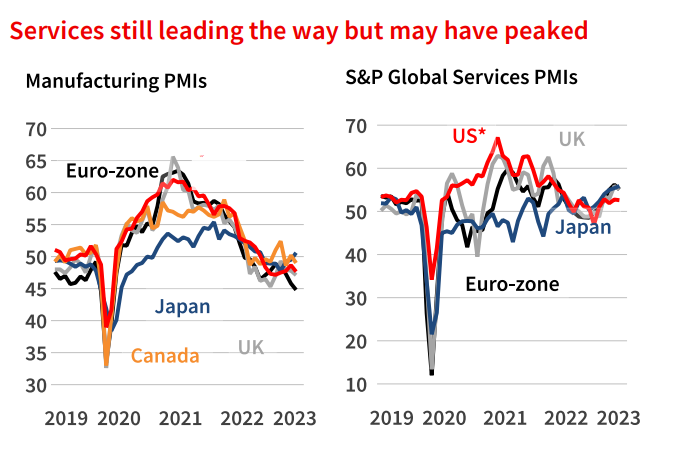
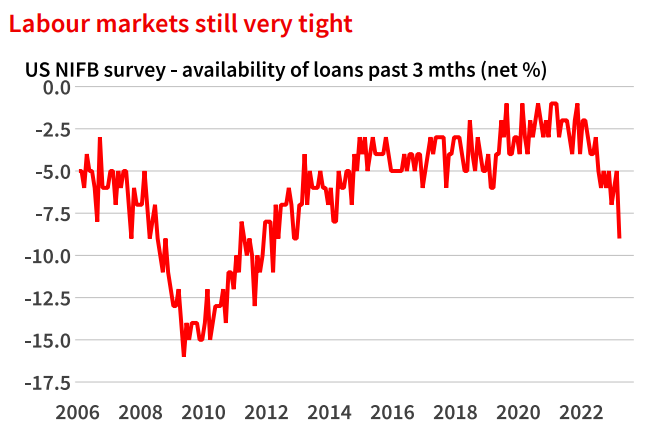
Emerging markets: service sector outperforming; manufacturing hit by weaker global demand
Business surveys in emerging markets remained
comparatively strong in May. Overall, the EM composite
PMI pushed higher to 55.6 points (from 54.9 points
previously), despite an easing in the services measure that
had been the key driver in recent months.
The EM manufacturing PMI moved up to 51.4 points (from
50.5 points in April). The key driver of this upturn was
China – where the Caixin manufacturing PMI switched
from a negative reading in April to a positive one in May –
supported by an upturn in India’s measure as well.
It is worth noting that China’s official manufacturing PMI
dropped further into negative territory in May.
Substituting this outcome for the Caixin measure would
result in the overall EM composite PMI pushing lower this
month – highlighting the importance of China to the
overall measure.
The EM services PMI drifted slightly lower – albeit
remaining at strongly expansionary levels – to 56.7 points
in May (from 57.3 points previously). Trends diverged
between major economies – with a stronger reading in
China offset by weaker results for both India (albeit
remaining very positive) and Russia.
The strength of China’s services PMI is somewhat at odds
with ongoing signs of weakness in the country’s domestic
demand. While not encompassing the complete range of
services, China’s retail sales growth has been relatively
weak (when accounting for the impact of base effects).
Similarly, consumer prices have barely increased in recent
months, and policy makers are mulling further stimulus –
including further monetary easing and support for the
beleaguered property sector. Given weakness in consumer
confidence, it is not clear that such measures would have
a material impact on China’s growth in the near-term.
India’s first quarter economic growth was stronger than
anticipated – increasing by 6.1% yoy (compared with
consensus forecasts around 5.0% yoy). While domestic
consumption was relatively subdued, strong growth in
capital investment and exports were key drivers of this
increase.
Growth in emerging markets is typically more trade
dependent than for advanced economies. The impact of
tightening financial conditions and the rebalancing of
consumption towards services is set to negatively impact
emerging markets in the near-term.
Global trade data are available to March and show a
surprise spike in EM export volumes in the final month.
This increase was driven by a 16.2% yoy increase in
exports from China – albeit this appears somewhat
anomalous. When a three-month moving average is
applied, the increase falls to just 1.3% yoy (highlighting
the weakness in both January and February), while
subsequent Chinese trade data has softened considerably.
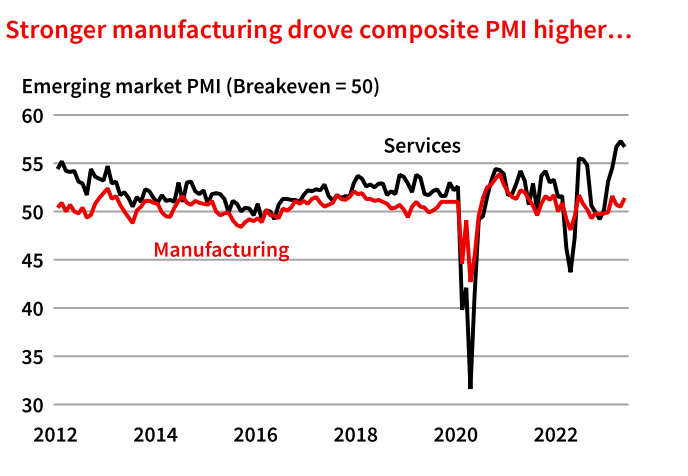
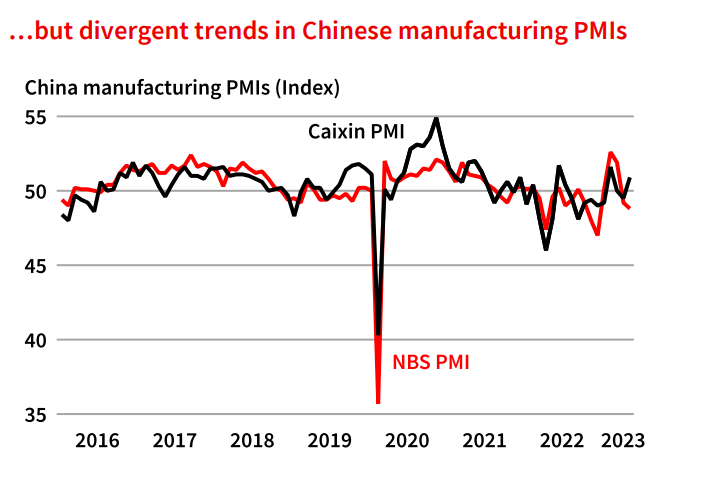
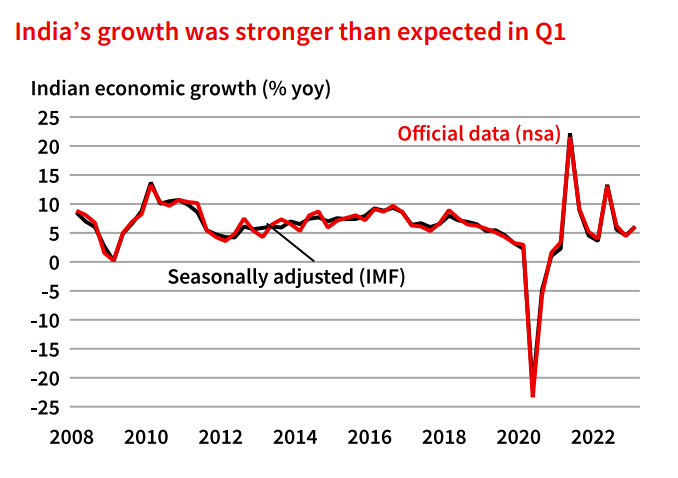

Global forecasts and risks: stronger near-term growth negatively impacts outlook for 2024
Global business surveys edged marginally higher in May,
with the JPMorgan global composite PMI at 54.4 points
(up from 54.2 points in April). The upturn in this measure
since December 2022 has been driven by the services
sector – with readings in both advanced economies and
emerging markets strengthening since late last year
(albeit EM services eased marginally from high levels in
May).
In contrast, the global manufacturing PMI has remained in
negative territory since September 2022. Modest gains in
the EM measure have been offset by declines in the
advanced economies.
This trend is broadly consistent with data on global
industrial production – where historically modest year-onyear growth in global output reflects aggregate gains in
EMs that were partially offset by lower production in
advanced economies.
Overall, our forecast for global economic growth in 2023 is
slightly higher this month – reflecting the impact of
stronger than anticipated activity in India, a pushing back
of the expected slowdown in US growth to H2 2023 (which
negatively impacts the global outlook in 2024) and a
pickup in Latin America. We expect the global economy to
expand by 2.8% in 2023 (from 2.7% previously), before
slowing to 2.6% in 2024 (2.7% previously). Excluding the
outliers of the Global Financial Crisis and initial wave of
COVID-19, this would be the slowest rate of growth since
2001. We expect a modest upturn in 2025 (to 3.1%).
There remain a range of risks to this outlook. This includes
uncertainty around monetary policy (given the persistence
of inflation above central bank targets) – with the risk that
various major central banks could hike policy rates above
our current expectations, leading to deeper than
anticipated slowing in activity (including the risk of
recession in many regions). Similarly, there is uncertainty
as to when the easing of monetary policy will commence.
In contrast, China’s economic recovery from its zeroCOVID policies appears close to stalling – with the
anticipated rebound in consumption yet to eventuate.
While policy makers have been considering stimulus,
proposals have largely been supply side measures, with
little indication that these will revive flagging demand.
While fears around financial stability in the US have cooled
again since early May, there remains risk of further strains
in the financial markets emerging. Further policy rate rises
could reveal previously unidentified vulnerabilities.
Similarly, there remain geopolitical risks to the outlook.
The Russia-Ukraine conflict has persisted for over a year,
with little prospect of a near-term resolution, while
tensions between China and the United States remain –
albeit with an opportunity for improvement with US
Secretary of State Blinken currently visiting China.

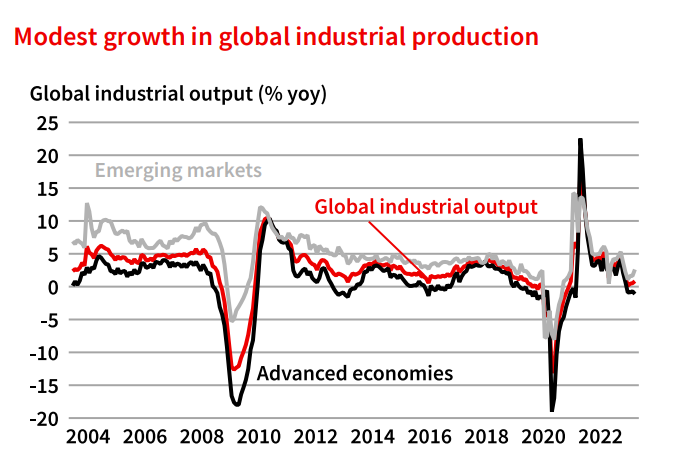
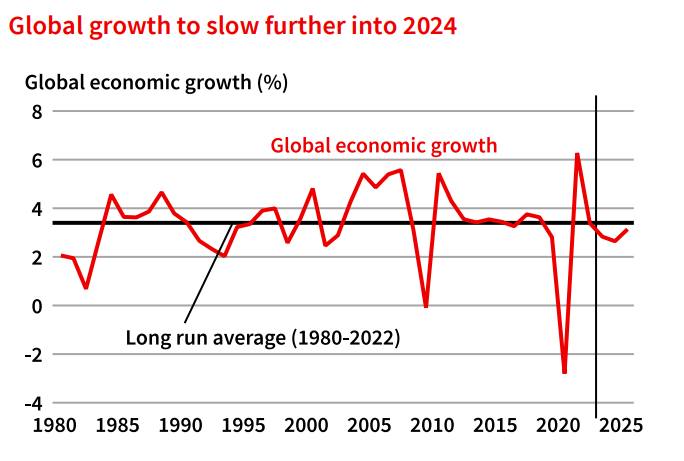
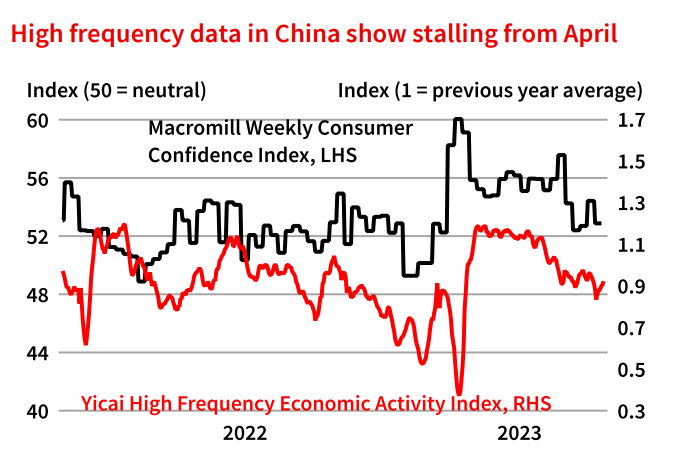
Group Economics
Alan Oster
Group Chief Economist
+(61 0) 414 444 652
Jacqui Brand
Executive Assistant
+(61 0) 477 716 540
Dean Pearson
Head of Behavioural &
Industry Economics
+(61 0) 457 517 342
Australian Economics
and Commodities
Gareth Spence
Senior Economist
+(61 0) 422 081 046
Brody Viney
Senior Economist
+(61 0) 452 673 400
Phin Ziebell
Senior Economist
+(61 0) 475 940 662
Behavioural &
Industry Economics
Robert De Iure
Senior Economist –
Behavioural & Industry
Economics
+(61 0) 477 723 769
Brien McDonald
Senior Economist –
Behavioural & Industry
Economics
+(61 0) 455 052 520
International
Economics
Tony Kelly
Senior Economist
+(61 0) 477 746 237
Gerard Burg
Senior Economist –
International
+(61 0) 477 723 768
Global Markets
Research
Ivan Colhoun
Chief Economist
Corporate & Institutional
Banking
+(61 2) 9293 7168
Skye Masters
Head of Markets Strategy
Markets, Corporate &
Institutional Banking
+(61 2) 9295 1196
Important notice
This document has been prepared by National Australia Bank Limited ABN 12 004 044 937 AFSL 230686 (“NAB”). Any advice
contained in this document has been prepared without taking into account your objectives, financial situation or needs.
Before acting on any advice in this document, NAB recommends that you consider whether the advice is appropriate for
your circumstances.
NAB recommends that you obtain and consider the relevant Product Disclosure Statement or other disclosure document,
before making any decision about a product including whether to acquire or to continue to hold it.
Please click here to view our disclaimer and terms of use.
